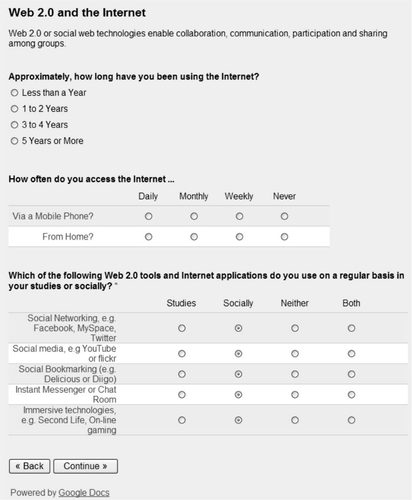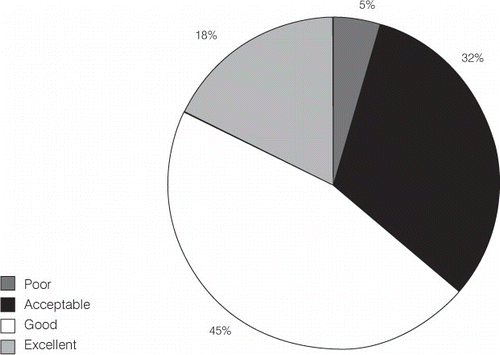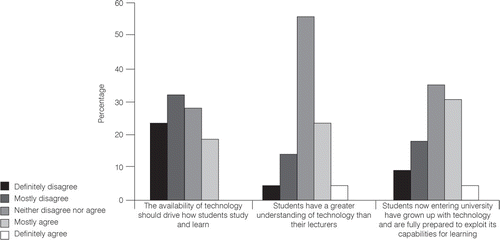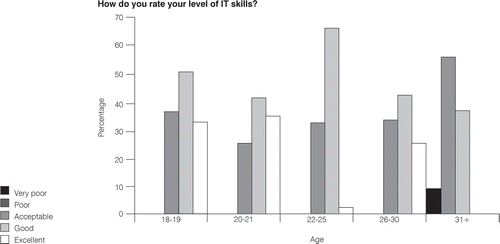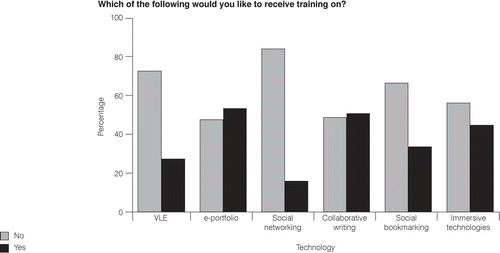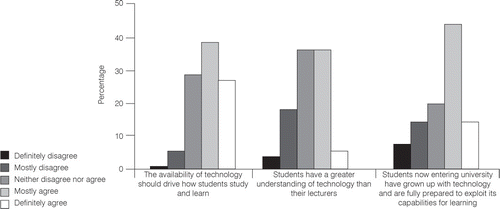Abstract
The introduction in the early 1990s of the world wide web was a significant factor in the creation of a global information society, allowing new possibilities to work, entertain and communicate, from home, at the workplace or on the move. In recent years, there have been significant advances in information technology (IT), while a new generation of applications that are able to harness the power of the world wide web has been introduced under the banner of Web 2.0. The increased capabilities of IT and the nature of Web 2.0 applications have attracted interest from the academic community as a means of enhancing the delivery of higher education. This paper considers the implications of introducing technology into the higher education sector from the perspectives of academic staff and students, with particular emphasis on the use of technology and Web 2.0 applications, and the relationship between technology and teaching and learning.
A combination of qualitative and quantitative methodologies has been adopted. Online questionnaires were completed by 22 members of academic staff and 107 students from the University of Bradford’s School of Engineering, Design and Technology. Interviews with university staff and the School’s undergraduate students complemented the questionnaires. The results demonstrate a good awareness and usage of technology among academic staff and students alike, with certain Web 2.0 applications (particularly social networking) being widely used by students but less so by academic staff. Overall, technology is largely viewed as a positive contributor to the learning experience.
Introduction
It has now been more than two decades since the introduction of the world wide web. Today, broadband internet access (be it to the workplace, home or on the move) is opening up new ways to work, entertain and communicate. As we enter the second decade of the twentyfirst century, we live in a technology-driven information society that was only just starting to take shape a generation ago.
The potential of employing technology in higher education (HE) is attracting growing interest from the academic community. A number of recent case studies funded by the Joint Information Systems Committee (JISC) and the repositioning of the e-learning strategy of the Higher Education Funding Council for England (HEFCE) have highlighted how technology can be incorporated into the delivery of HE (CitationJISC, 2009; CitationHEFCE, 2009). A recent special issue of Engineering Education also showcased a variety of opportunities that technology has to offer (CitationHigher Education Academy Engineering Subject Centre, 2009).
The delivery of HE, as with many aspects of society in general, is being shaped more and more by the world wide web. In particular, Web 2.0 applications have become increasingly popular over recent years (CitationO’Reilly, 2007; CitationJISC, 2007). The broad aim of Web 2.0 is to change the way in which the user interacts with the world wide web, from passively consuming information (which was typical of the first few years of web usage) to actively participating in the creation of media content and dispersion of knowledge.
Despite the opportunities that the web has to offer, the rollout of web-based learning and teaching initiatives has yet to enter the mainstream to any degree. Why should this be the case? Are there barriers that are preventing mainstream adoption of Web 2.0 applications in supporting the delivery of HE? Is there a difference between students and their lecturers in how they employ technology? Can an institution do anything to encourage the widespread adoption of web technology as part of its pedagogical approach? These questions form the basis of this paper.
The objectives of the paper are to identify the degree of familiarity of academic staff and students with information technology (IT) and Web 2.0 applications, identify any training needs and obtain the respective views on the relationship between technology and pedagogy. To this end, the paper adopts a case study approach, drawing upon the experiences and opinions of students and members of staff at the University of Bradford. The university was established in 1966 and is of medium size, with around 10,000 students, of which 85% are undergraduates. About a fifth of undergraduates are international, rising to 50% of postgraduates. The School of Engineering, Design and Technology (SoEDT), on which the paper focuses, was established in 2002 and currently offers undergraduate and postgraduate programmes in Chemical Engineering, Civil and Structural Engineering, Design, Electronics and Telecommunications, Information Technology, and Mechanical and Medical Engineering. The school has around 1200 students (including about 150 at postgraduate level) and 60 members of academic staff.
The adoption of digital technologies
In a relatively short timeframe, Web 2.0 applications have brought about a change in how users engage with the world wide web. This can be seen, for example, in the growth in popularity of social media tools, such as Facebook and Twitter. The interactive and inclusive nature of Web 2.0 applications offers the potential to deliver innovative new ways of learning and teaching within the HE environment. For example, group work and team building could be facilitated through social networking tools, blogs could be used to record a student’s learning experience over a period of time (CitationChurchill, 2009), while wikis could be used by teachers to introduce the concept of collaborative group writing.
When considering the likely users of Web 2.0 in HE delivery, there are two possible direct beneficiaries: students and lecturers. Certainly, the vast majority of today’s students (those born during the early years of the 1990s) have grown up as part of an information society.
It could be expected that most of today’s students are fully au fait with the potential offered by the world wide web environment. However (using a similar counter-argument), this may not be the case for teaching staff, the majority of whom will have been born prior to the era of the mobile phone and the desktop computer. At the beginning of the millennium it was suggested that there would be a difference in the way that students who have grown up in today’s information society, sometimes referred to as the net generation (CitationTapscott, 1998) or digital natives, and teachers born prior to the emergence of the digital communications era dubbed digital immigrants (CitationPrensky, 2001), adopt and employ technology for learning and teaching. In recent years this clear distinction between natives and immigrants has been questioned. CitationBennett et al. (2008) cite a lack of empirical evidence and theoretical foundations to support the distinction between digital native and immigrant, while CitationHelsper and Eynon (2010) argue that a digital native is not defined simply by age but also by breadth of internet use and experience of using internet technologies. CitationMargaryan et al. (2011) found that only a limited range of established technologies were used for learning and socialising among students on a range of engineering and social work courses at two universities, with greater use of tools by the engineering students. CitationJones et al. (2010) highlighted variations in the use of technologies by age, university and course amongst students drawn from five universities. Casting further doubt on the homogeneous net generation, four different types of technology user were identified by CitationKennedy et al. (2010) from a population of first year students drawn from three universities in Australia. Without labelling according to background or age, rather by considering motivation and context, CitationWhite and Le Cornu (2011) introduce the visitors and residents continuum to describe online behaviour, replacing the digital native and immigrant concept.
From this brief literature review, it seems apparent that a simple dichotomy of the digital capabilities of students and their lecturers is no longer considered to be an accurate representation. One of the themes of the research reported in this paper is to better understand the capabilities of engineering students entering a university similar to Bradford, with the intention of contributing to the available literature on the subject. The paper also considers the digital capabilities of academic staff, so far largely ignored in the literature. In so doing, a rounded analysis of the use of technologies in the lecture theatre is presented, with a view to evaluating the degree of familiarity and level of usage of technology among staff and students.
Research methodology
Quantitative and qualitative research
The adoption of Web 2.0 applications within mainstream HE has yet to gather pace to any significant degree, with organisations reliant on champions and innovators to raise awareness and promote the opportunities on offer (CitationClex, 2009). Within SoEDT, technology plays a supporting role in programme delivery, with the widespread adoption across campus of a commercial “off the shelf” virtual learning environment (VLE), while other applications (such as e-portfolio tools) have yet to be widely employed across the school. With the exception of the VLE, lecturers in SoEDT are more or less free to employ technology as they see fit. The university has experimented with employing technology in teaching, for example the JISC-funded Audio supported enhanced learning (ASEL) project which demonstrated how the use of audio recordings and podcasts can enhance the learning experience (CitationStewart, 2009).
In order to gain an appreciation of the current situation regarding the use of technology and the take-up of Web 2.0 applications within SoEDT, an exploratory research project was carried out from October 2009 to March 2010. The research involved members of staff and SoEDT’s undergraduate and postgraduate students. A combination of complementary quantitative and qualitative research methods was used. Quantitative data were obtained from online questionnaires, while qualitative data were derived from face-to-face semi-structured interviews and textual responses to the online questionnaires.
Interviews
16 face-to-face semi-structured interviews were conducted between 30 November and 18 December 2009. 12 University of Bradford staff interviewees were selected on the basis of their job function, including senior management, academics and technical and learning support staff. All SoEDT students were invited to participate via email and posters on the school’s noticeboards. Four undergraduate volunteers responded. Students were interviewed in convenient meeting rooms on campus.
Interview questions were divided into core, to which all participants had to respond, and supplementary, asked when time was available. As far as possible, common questions were used for both members of staff and students, with deviations and additional questions used to accommodate the different perspectives of the two groups. All interviews were recorded and transcribed verbatim.
Questionnaires
Online structured questionnaires were generated for staff and students. Participation (from 19 November to 21 December 2009) was invited via email and noticeboard announcements. Both questionnaires were divided into six sections:
about you
technology usage
technology infrastructure
Web 2.0 and the internet
training and development
technology and its use in learning.
As a means of collecting qualitative data, each section comprised questions in various formats, including the facility for open ended freeform text input. Some questions were mandatory and others optional. Closed questions were used to generate quantitative data. Nominal scales were applied when collecting demographic information. Whenever possible, the same questions were asked of both staff and students. Returns for the questionnaires were anonymous and time stamped. A sample page from the student questionnaire derived using the Google Docs application is shown in .
Results
Introduction
In this section, selected data from the online questionnaires for staff and students are provided, interspersed with relevant quotations derived from interviews and textual responses to the questionnaires.
Demographics
Interviews
The members of staff that were interviewed comprised two members of senior management, two Deans, members of the Teaching Quality Enhancement Group and lecturing, technical and learning support staff. Members of staff were drawn from three schools: SoEDT, Computing, Informatics and Media, and Management. The interviews with students were with four SoEDT undergraduate students: two first years, one second year and one third year.
Once interviews had been transcribed, postprocessing involved the generation of an index in order to identify common and regularly occurring themes. The dominant subject of the interviews was learning technology. The subjects technology and students were also prominent discussion areas.
Surveys
The compulsory demographic part of the staff survey characterised respondents in terms of job function (academic, academic related, administrative, technical), gender, age and experience. 22 members of academic staff completed the online questionnaire - a response rate of 37%, with just under two-thirds of the respondents being male. All returns were considered valid. Half of those that completed the survey were aged between 51 and 60, placing them very much in the category of digital immigrant (CitationPrensky, 2001). Only one member of staff was in the 26–30 age range. In terms of experience, members of staff with between one and ten years accounted for 62% of returns; 27% had more than 20 years.
The compulsory part of the student survey characterised respondents in terms of gender, age, programme of study and origin. The student population was drawn from SoEDT. The majority of students that completed the survey (79%) were male. In total, 107 students completed the survey, corresponding to a response rate of about 9%. Two-thirds of the respondents were aged between 20 and 25 years old; 13% were in the 18–19 age range. Just over 75% of those surveyed were on Bachelor degree programmes; postgraduate students made up 22% of respondents. At 44%, international students represented the largest cohort, with students from the UK and from the rest of Europe equally represented at 28% each.
Key findings
Academic staff
In order to evaluate the capacity for academic staff to introduce Web 2.0 initiatives to their pedagogical approach, the following results from the survey are highlighted. In particular, a self-evaluation of IT skills is presented before assessing how Web 2.0 tools are currently employed by academic staff. The need for training in particular technologies is addressed, then more specific technology usage in relation to pedagogy is considered.
Information technology and Web 2.0 usage The use of IT is firmly part of today’s working environment. However, could a lack of understanding of IT among academic staff be restricting its use in teaching? When asked to rate their IT skills, most academics (63%) considered themselves to have at least good proficiency. Only 5% of respondents indicated a poor proficiency. This suggests that there is no lack of confidence in the ability to employ IT in the workplace. The results are summarised in .
As noted in the introduction, one area of technology that has attracted significant recent interest is Web 2.0 applications. Today, the most widely used Web 2.0 applications have been generated through the growth in popularity of social networking sites, with Facebook, LinkedIn and Twitter, in particular, continuing to increase their memberships at rapid rates of annual growth (CitationOfcom, 2010). Web 2.0 is not, however, limited to social networking. Social media sites (such as YouTube) enable users to upload media content to an application server and share it with the internet community. In an engineering context, lecturers may wish to upload their presentations or students could, for example, provide video updates of project work when working off-campus. In a similar vein, social publishing through Wikis enables users to collaborate on the writing of documents, and blogs provide a medium for self-expression and personal reflection over a period of time. Social bookmarking sites permit users to share bookmarked websites, in which lies potential for research activity, while immersive technologies allow users to interact with others within virtual world environments. In this part of the survey, ways in which academic staff employed various Web 2.0 tools in a work or social context were examined.
Overall (as shown in ), the results demonstrate modest usage amongst academic staff of most Web 2.0 tools. Taking into account work and social use, social networking was employed by roughly one-third of academics, while instant messaging was used by 41%. One member of staff commented that ‘I use Facebook for social networking, so for me I wouldn’t want to mix the social networking site with what is in education.’ Only social media (such as YouTube) accounted for majority usage, with 55% of academics claiming to use it for work or social purposes. Social bookmarking tools and immersive technologies were very much a minority interest. All academic staff indicated that they had been using the internet for five years or more. Technology usage amongst academics varied as follows: iPod or MP3 player (9%); digital camera (32%); notebook/netbook computer (63.6%); 3G or iPhone (45.5%); PDA or Blackberry (4.5%); eBook (13.6%); desktop PC (86.4%) and voice recorder (13.6%). All 22 respondents indicated that they access to the internet at home, 19 on a daily basis, while ten respondents indicated that they had never accessed the internet via a mobile phone.
In order to encourage the take-up of technologies, training in specific areas, perhaps as part of a continuous professional development programme, may be appropriate. The questionnaire asked respondents to indicate whether there was a need for individual training in the use of specific Web 2.0 tools, as well as in the use of the other web tools made available by the university, specifically the VLE and e-portfolio tool.
There was very little interest in receiving training on social networking and bookmarking tools, while around a third of respondents would welcome training on the VLE, e-portfolio tools and immersive technologies (). Collaborative writing was identified as the area where training was of most interest, although this was still a minority view.
Technology and its relationship with pedagogy In this part of the survey, consideration was given to the relationship between technology and pedagogy. In analysing what technologies should be used to support the delivery of lectures, four approaches were considered: podcasts, video recordings, audio recordings and online discussion forums. Podcasts are considered here to be recordings that are made to provide additional information in support of a lecture course, whereas video and audio recordings can be thought of as actual recordings of lectures or seminars given to students. CitationStewart (2009) discussed examples of how podcasts have been used by the University of Bradford for lecture summaries, summative and formative audio feedback and group discussions as part of the Audio supported enhanced learning (ASEL) project. Online discussion forums can be used outside of the lecture theatre by lecturers and students to discuss and develop particular aspects of the lecture. The results are summarised in .
Figure 5. Academic staff’s responses to the question “what technologies should be used by lecturers to support the delivery of their lecture material?”
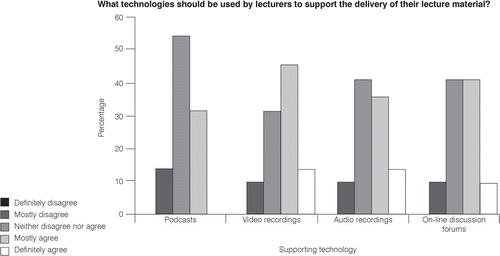
Table 1. Students’ average response by age range to the question “how do you rate your level of IT skills?”
There was strong support amongst academic staff for all types of technology to be employed in supporting lecture material (). Video recordings and online discussion forums proved particularly popular, with one member of staff commenting that ‘some of the podcasts I have seen have been really nice and actually bring the learning experience to the student.’
Finally, in order to evaluate academic staff’s views on the relationship between technology and pedagogy, the following statements were posed:
The availability of technology should drive how students study and learn.
Students have a greater understanding of technology than their lecturers.
Students now entering university have grown up with technology and are fully prepared to exploit its capabilities for learning.
A summary of the responses to the statements on the relationship between technology and education is shown in . The majority of academic staff was not in favour of technology driving pedagogy, with one respondent commenting that ‘we need to look at teaching approaches first before we start to even consider the technology.’
There was no strong view on whether students had a better understanding of technology than lecturers, with more than half of respondents being non-committal. On the other hand, 58% of staff agreed that students who had grown up with technology should be fully prepared to exploit its capabilities for learning.
Students
Information technology and Web 2.0 usage As with academic staff, students were asked to rate their level of IT skills. and summarise the results. , which was derived using a 5-point Likert scale (1 = very poor; 5 = excellent), shows that those aged between 20 and 21 have the highest average rating, with illustrating the significant number of students in this age range that ranked their IT skills as excellent. The overall average of 3.82 is close to the academic staff average of 3.77, suggesting that there is little difference in the perceived level of IT competence between students and academic staff.
While students entering HE may be familiar with Web 2.0 technologies and have at their disposal smartphones, broadband internet access, MP3 players and netbook computers (CitationClex, 2009), research to date suggests that they do not appreciate fully how such tools can be applied to their studies (JISC, 2008). The results of the survey assessing the degree to which students use Web 2.0 applications (for study or socially) corresponded in some respects to the staff survey, although there are obvious differences in social networking and social media usage.
As illustrated in , students employ social networking largely as a social tool, although this may be due (at least in part) to a lack of exposure in a learning context. On the other hand, social media and messaging and chat room services are being applied academically, as well as socially. The separation of social and academic usage of social network applications was further emphasised during the interviews, with one undergraduate commenting that ‘I think it should be for social reasons first, and not used for education’ and another saying that ‘Facebook of course is predominantly at the moment for me a social thing, so if you suddenly went academic with Facebook you would need to have say a small forum area where you could start playing around with questions.’ As in the case of academic staff, social bookmarking and immersive technologies did not have mainstream support to any degree.
Just under 90% of students indicated that they had been using the internet for five years or more. As shown in , technology usage among students of all ages is largely dominated by the net- or notebook computer, with nearly 85% of 20–21 year olds having such a device. Desktop computers become more popular with age, while iPods or MP3 players tend to be favoured by those in the 18–25 age range. Digital cameras and recorders enjoy significant usage across the age spectrum. illustrates that international students have the greatest ownership of 3G mobile technology, while European and international students are the main users of ebooks and digital cameras and recorders.
Table 2. Technology usage amongst students by age
Table 3. Technology usage amongst students by country of origin
In terms of training needs (see ), there was little interest in developing skills in the VLE and social networking, which given the adoption rate is perhaps not surprising, but there was a majority interest in training on e-portfolio and collaborative writing.
Technology and its relationship with pedagogy With regard to supporting lecture material, the results for the four technologies considered (podcasts, video recordings, audio recordings and discussion forums) are presented in and . The results in , derived from the previously defined 5-point Likert scale, show a high level of interest in the use of technologies in support of lectures, especially by those aged over 25. On average, of the four technologies, podcasts were the least favoured, whereas video recordings and online discussion forums engendered the most enthusiasm.
Table 4. Students’ average response by age range to the question “what technology should be used by lecturers to support the delivery of their lecture material?”
Figure 10. Students’ responses to the question “what technology should be used by lecturers to support the delivery of their lecture material?”
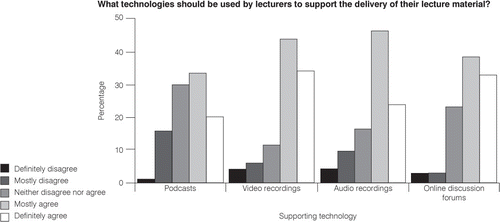
Table 5. Students’ average response by age range on issues relating to technology and education
An undergraduate student commented that ‘to have videotaping of the lecture and probably just having some kind of audio recording, as well. It would just be advantageous to maybe later to download and listen or review the lecture.’
An overall summary of the responses to the questions on the relationship between technology and education is shown in and . The latter, derived from the previously defined 5-point Likert scale, illustrates a progressive support with age for the use of technology to drive pedagogy. On the other hand, the belief that students have a greater understanding of technology than their lecturers declines (on the most part) with age. The results highlight how students, particularly in the 18–19 age group, having grown up with technology are confident with it and willing to employ it in the learning environment.
Limitations of work
While the technology under discussion can be applied to most subject areas, the collected data has focused on a particular school (SoEDT) and university (Bradford). There is value in analysing a specific subject area as this has been shown to influence technology usage (CitationJones et al., 2010); however, by targeting a particular cohort of students, the applicability of the data collection exercise in the wider context of HE will be limited in some respects. This goes for both members of staff and student analyses, although for members of staff the semi-structured interviews with non- SoEDT members helped to provide a wider perspective.
This paper provides a snapshot of the situation in a typical engineering school in the UK. The online method of collecting survey results may have introduced an element of bias into the proceedings, as only those comfortable with using computers and the internet are likely to have participated. In this respect, some views may have been inadvertently neglected, while others, such as capability with technology, may have been exaggerated. On the whole, the number of students who completed the survey (>100) was sufficiently large to draw conclusions with some degree of confidence. Segmentation of students into age groups showed that nearly two-thirds of those who completed the survey were in the 20–25 year range, with other age groups being less well represented. A greater number of returns in the 18–19 and 26+ age groups would have strengthened the analysis by allowing greater interpretation of the influence of age on the questionnaire’s results.
22 returns by members of academic staff provided a sufficient number to draw conclusions of a general nature but a greater number of returns would have increased confidence in the data.
Conclusion
A decade on from the identification of the digital native and digital immigrant (CitationPrensky, 2001), the differences in how students and lecturers approach technology in the classroom may be expected to be even more pronounced.
Technology is being used throughout the HE sector. During the course of research for this paper, it became evident that it was not a question of whether technology should be used to enhance education, more the degree to which it will become embedded in the pedagogy and how long it will take to diffuse throughout the academic community.
There is a discrepancy in the use of Web 2.0 technologies, with academic staff being largely non-users, compared to students who regularly use social networking tools. More broadly, academic staff and students seem equally at home with technology. Nevertheless, the widespread adoption of Web 2.0 applications as part of the teaching and learning environment is unlikely to occur while the level of interest among academic staff remains low.
There are differences between the digital capabilities of students and academics, such as the use of social networking tools, but, even in this case, a recent survey suggests that nearly half of those in the 35-54 age range access social networking sites (CitationOfcom, 2010). While not all academic staff may be au fait with Facebook or Twitter, innovations such as VLEs have been gradually introduced throughout HE, suggesting an ability to accommodate new technology when the need arises.
The idea that students have a superior grasp of today’s technologies and are therefore better equipped to apply this knowledge in an educational context stems from the notion that contemporary students have grown up within a maturing information society (CitationPrensky, 2001). From today’s vantage point, the capabilities of modern day technology appear endless, no doubt in much the same way as they must have appeared when the notion of digital natives and digital immigrants was first conceived. However, what could be achieved with available bandwidth and computing power only a decade ago bears little resemblance to the content-rich applications of today. While today’s students may have grown up with technology, it is only in the last five years or so that technological advances have been sufficient to introduce the new transformational services that are reshaping our cultural environment. In this respect, while digital technologies may have provided the foundation for the information society, the type of applications that we are seeing today (including Web 2.0 technologies) have been shaped by relatively recent advancements in computer processing and transmission bandwidth capabilities. Moreover, smartphones are driving demand for mobile broadband services, with the potential to open up new ways of accessing educational content.
In practice, today’s HE communities are likely to offer a mix of technical backgrounds, where digital natives and digital immigrants are as likely to be found among the student cohort as among members of staff. While it may be convenient to imagine a technological gulf between the digital capabilities of students and academic staff, in practice, the situation is less clear cut.
Acknowledgements
The author would like to thank the staff and students from the School of Engineering, Design and Technology that completed the online questionnaires, as well as students and colleagues that were interviewed, for their valuable contributions to this research.
References
- BennettS. MatonK. and KervinL. (2008) The ‘digital natives’ debate: a critical review of the evidence. British Journal of Educational Technology, 39 (5), 775-786.
- ChurchillD. (2009) Educational applications of Web 2.0: using blogs to support teaching and learning. British Journal of Educational Technology, 40 (1), 179-183.
- CLEX (Committee of Inquiry into the Changing Learner Experience) (2009) Higher education in a Web 2.0 world: report of an inquiry into the impact of higher education of students’ widespread use of Web 2.0 technologies. Available from http://www.jisc.ac.uk/media/documents/publications/heweb20rptv1.pdf [accessed 28 November 2011].
- Higher Education Academy Engineering Subject Centre (2009) Engineering Education: Journal of the Higher Education Academy Engineering Subject Centre. Special Issue: Learning Technologies in Engineering Education, 4 (2).
- HEFCE (2009) Enhancing learning and teaching through the use of technology: a revised approach to HEFCE’s strategy for e-Learning. Available from http://www.hefce.ac.uk/Pubs/hefce/2009/09_12/ [accessed 28 November 2011].
- HelsperE. and EynonR. (2010) Digital natives: where is the evidence? British Educational Research Journal, 36 (3), 503-520.
- JISC (2007) Web 2.0 and social software: an introduction. Available from http://www.jisc.ac.uk/media/documents/publications/web2socialsoftwarev1pdf.pdf [accessed 28 November 2011].
- JISC (2009) Effective practice in a digital age: a guide to technology-enhanced learning and teaching. Available from http://www.jisc.ac.uk/media/documents/publications/effectivepracticedigitalage.pdf [accessed 28 November 2011].
- JISC infoNET (2008) Exploring tangible benefits of e-Learning: does investment yield interest? Available from http://www.jiscinfonet.ac.uk/publications/camel-tangible-benefits.pdf [accessed 28 November 2011].
- JonesC. RamanauR. CrossS. and HealingG. (2010) Net generation or digital natives: is there a distinct new generation entering university? Computers and Education, 54 (3), 722-732.
- KennedyG. JuddT. DalgarnoB. and WaycottJ. (2010) Beyond natives and immigrants: exploring types of net generation students. Journal of Computer Assisted Learning, 26 (5), 332-343.
- MargaryanA. LittlejohnA. and VojtG. (2011) Are digital natives a myth or reality? University students’ use of digital technologies. Computers and Education, 56 (2), 429-440.
- Ofcom (2010) Ofcom communications market report. Available from http://stakeholders.ofcom.org.uk/binaries/research/cmr/753567/CMR_2010_FINAL.pdf [accessed 28 November 2011].
- O’ReillyT. (2007) What is Web 2.0? Design patterns and business models for the next generation of software. Communications & Strategies, 65 (1st quarter), 17-37.
- PrenskyM. (2001) Digital natives, digital immigrants. On the Horizon, 9 (5), 1-10.
- StewartW. (2009) Audio supported enhanced learning. London: JISC.
- TapscottD. (1998) Growing up digital: the rise of the NET generation. New York: McGraw-Hill.
- WhiteD.S. and Le CornuA. (2011) Visitors and residents: a new typology for online engagement. First Monday, 16 (9). Available from http://www.uic.edu/htbin/cgiwrap/bin/ojs/index.php/fm/article/viewArticle/3171/3049, [accessed 28 November 2011].
